Nonlinear Interactions and Dynamic Analysis of Ecosystem Resilience and Human Activities in China’s Potential Urban Agglomerations
Abstract
1. Introduction
1.1. Conceptual Evolution and Analytical Frameworks of ER
1.2. Quantification of HAI and Its Impact on ER
1.3. Potential Urban Agglomeration: XZUA
1.4. Research Gaps, Innovations, and Fundamental Hypotheses
2. Materials and Methods
2.1. Flowchart
2.2. Study Area
2.3. Data Sources
2.4. Methods
2.4.1. Multi-Source Data Human Activity Intensity Model
- (1)
- Explicit Indicator
- (2)
- Implicit Indicator
2.4.2. Ecosystem Resilience Assessment Framework
- (1)
- Static Indicator
- (2)
- Dynamic Indicator
2.4.3. Sen’s Slope and Mann–Kendall Test Model
2.4.4. MGWR and OPGD Models
2.4.5. Bivariate Spatial Autocorrelation
3. Results
3.1. HAI and ER Assessment Results
3.2. Spatial Pattern and Correlation Analysis
3.2.1. Shift in Center of Gravity Analysis
3.2.2. Multi-Scale Correlation Analysis
3.3. Trend Analysis
3.3.1. Temporal Dynamics
3.3.2. Linear and Non-Linear Driving Analysis
4. Discussion
4.1. Nonlinear Dynamics and Spatiotemporal Mismatch in HAI–ER
4.2. Threshold Effects and Interactive Drivers of HAI Impact
4.3. Spatial Drivers and Heterogeneity in HAI–ER Relationships
4.4. Policy Recommendations Based on the Zoning Strategy
- (1)
- Eastern regions (HAI local positive coefficients): Where HAI positively contributes to ER, coordinated development can yield mutual benefits. In low-HAI areas—such as peri-urban or agricultural zones—planning should promote synergistic growth through green infrastructure, compact development, and transit-oriented development (TOD). Integrating the development of production space within urban–rural planning frameworks is essential. As potential pilots for balanced growth, these areas must also guard against ecological spillovers from adjacent high-HAI regions [96]. Where HAI is already high, policy should shift from expansion to consolidation, focusing on land use efficiency and ecological protection.
- (2)
- Western and central regions (HAI local negative coefficients): In areas where HAI intensity undermines ER, regulation must be strengthened. In high-HAI zones, compact development can curb sprawl but must be accompanied by investments in environmental quality, public services, and housing to avoid the “compact city paradox” [97]. Urban growth boundaries should align with EKC thresholds to avoid irreversible ecological stress. In low-HAI zones, policy should focus on conserving ecological buffers and preventing premature development through zoning regulations, habitat restoration [98], and advanced irrigation systems [99]. Fiscal ecological compensation mechanisms should be implemented to manage ecological spillovers and incentivize local stewardship [79].
- (3)
- Zones with steep HAI Sen’s slopes, often located in peri-urban belts of potential urban agglomerations, reflect rapid transitions and weak ER. The goal is to moderate HAI fluctuations and stabilize regional dynamics. Three strategies are recommended: support green and low-carbon industries while enhancing inter-city industrial coordination to improve self-organization [77]; stabilize population flows by improving access to services, housing, and employment in high out-migration areas; and reinforce governance capacity through spatial monitoring and better institutional integration. These measures can mitigate systemic uncertainty and strengthen the adaptive capacity of potential urban agglomerations.
4.5. Limitations and Future Directions
5. Conclusions
- (1)
- Nonlinear Dynamic Trends: ER followed a “shock–recovery” trajectory with a net decline of 3.202%, while HAI exhibited a “rise–fall” pattern with an overall decrease of 0.800%, indicating non-linear human–ecological dynamics.
- (2)
- Strengthening Spatial Mismatch: A growing mismatch between HAI and ER was observed (bivariate Moran’s I increased from 0.296 to 0.380), with both indices trending downward (Sen’s slope < 0), underscoring the need to enhance human–land coordination.
- (3)
- Spillover Effects: ER degradation occurred in low-HAI areas adjacent to high-HAI zones, revealing indirect ecological pressures linked to urban expansion.
- (4)
- Dynamic HAI as a Dominant Driver: HAI Sen’s slope exerted the strongest impact on ER change (q = 0.512), exceeding static HAI mean and natural factors. Its interaction with precipitation (q = 0.802) highlights climate–human co-regulation mechanisms.
- (5)
- Spatial Stability of HAI Variation: Compared to intensity, temporal fluctuations in HAI showed more consistent spatial influence on ER, emphasizing the importance of monitoring change dynamics.
Author Contributions
Funding
Data Availability Statement
Acknowledgments
Conflicts of Interest
Appendix A
| No. | Land Type | Description | CI * | RLC ** |
|---|---|---|---|---|
| 1 | Forest | Type 1–5, including evergreen needleleaf/broadleaf forests, deciduous needleleaf or broadleaf forests, mixed forests. | 0.010 | 1.000 |
| 2 | Shrubland | Type 6–7, including closed/open shrublands. | 0.133 | 0.800 |
| 3 | Grassland | Type 8–10, including woody savannas, savannas, grasslands. | 0.067 | 0.700 |
| 4 | Wetland | Type 11, including permanent wetlands. | 0.067 | 0.600 |
| 5 | Farmland | Type 12, 14, including croplands, cropland/natural vegetation mosaics. | 0.200 | 0.500 |
| 6 | Artificial Surface | Type 13, including urban and built-up lands. | 1.000 | 0.300 |
| 7 | Barren | Type 16, including barren land. | 0.000 | 0.200 |
| 8 | Water | Type 15, 17, including permanent snow and ice, water bodies. | 0.000 | 0.800 |
Appendix B
Appendix B.1
Appendix B.2
Appendix B.3
Appendix B.4
References
- Halpern, B.S.; Frazier, M.; Potapenko, J.; Casey, K.S.; Koenig, K.; Longo, C.; Lowndes, J.S.; Rockwood, R.C.; Selig, E.R.; Selkoe, K.A. Spatial and Temporal Changes in Cumulative Human Impacts on the World’s Ocean. Nat. Commun. 2015, 6, 7615. [Google Scholar] [CrossRef] [PubMed]
- Jones, K.R.; Venter, O.; Fuller, R.A.; Allan, J.R.; Maxwell, S.L.; Negret, P.J.; Watson, J.E. One-Third of Global Protected Land Is under Intense Human Pressure. Science 2018, 360, 788–791. [Google Scholar] [CrossRef] [PubMed]
- Wang, Y.; Cai, Y.; Xie, Y.; Zhang, P.; Chen, L. A Quantitative Framework to Evaluate Urban Ecological Resilience: Broadening Understanding through Multi-Attribute Perspectives. Front. Ecol. Evol. 2023, 11, 1144244. [Google Scholar] [CrossRef]
- FAO; IUCN/CEM. SER Principles for Ecosystem Restoration to Guide the United Nations Decade 2021–2030; FAO: Rome, Italy, 2021. [Google Scholar]
- Hu, H.; Yan, K.; Shi, Y.; Lv, T.; Zhang, X.; Wang, X. Decrypting Resilience: The Spatiotemporal Evolution and Driving Factors of Ecological Resilience in the Yangtze River Delta Urban Agglomeration. Environ. Impact Assess. Rev. 2024, 106, 107540. [Google Scholar] [CrossRef]
- Holling, C.S. Resilience and Stability of Ecological Systems; Cambridge University Press: Cambridge, UK, 1973. [Google Scholar]
- Martin, R. Regional Economic Resilience, Hysteresis and Recessionary Shocks. J. Econ. Geogr. 2012, 12, 1–32. [Google Scholar] [CrossRef]
- Ouyang, M.; Dueñas-Osorio, L.; Min, X. A Three-Stage Resilience Analysis Framework for Urban Infrastructure Systems. Struct. Saf. 2012, 36, 23–31. [Google Scholar] [CrossRef]
- Vázquez-González, C.; Ávila-Foucat, V.S.; Ortiz-Lozano, L.; Moreno-Casasola, P.; Granados-Barba, A. Analytical Framework for Assessing the Social-Ecological System Trajectory Considering the Resilience-Vulnerability Dynamic Interaction in the Context of Disasters. Int. J. Disaster Risk Reduct. 2021, 59, 102232. [Google Scholar] [CrossRef]
- Alberti, M.; Marzluff, J.M. Ecological Resilience in Urban Ecosystems: Linking Urban Patterns to Human and Ecological Functions. Urban Ecosyst. 2004, 7, 241–265. [Google Scholar] [CrossRef]
- Hudec, O.; Reggiani, A.; Šiserová, M. Resilience Capacity and Vulnerability: A Joint Analysis with Reference to Slovak Urban Districts. Cities 2018, 73, 24–35. [Google Scholar] [CrossRef]
- Zhu, E.; Gao, H.; Chen, L.; Yao, J.; Liu, T.; Sha, M. Interactions between Coastal Protection Forest Ecosystems and Human Activities: Quality, Service and Resilience. Ocean Coast. Manag. 2024, 254, 107190. [Google Scholar] [CrossRef]
- Zhang, C.; Zhou, Y.; Yin, S. Interaction Mechanisms of Urban Ecosystem Resilience Based on Pressure-State-Response Framework: A Case Study of the Yangtze River Delta. Ecol. Indic. 2024, 166, 112263. [Google Scholar] [CrossRef]
- Guo, W.; Huang, S.; Huang, Q.; Leng, G.; Mu, Z.; Han, Z.; Wei, X.; She, D.; Wang, H.; Wang, Z.; et al. Drought Trigger Thresholds for Different Levels of Vegetation Loss in China and Their Dynamics. Agric. For. Meteorol. 2023, 331, 109349. [Google Scholar] [CrossRef]
- Yao, Y.; Fu, B.; Liu, Y.; Li, Y.; Wang, S.; Zhan, T.; Wang, Y.; Gao, D. Evaluation of Ecosystem Resilience to Drought Based on Drought Intensity and Recovery Time. Agric. For. Meteorol. 2022, 314, 108809. [Google Scholar] [CrossRef]
- Li, D.; Meng, W.; Liu, B.; Xu, W.; Hu, B.; Huang, Z.; Lu, Y. Temporal-Spatial Change of China’s Coastal Ecosystem Resilience and Driving Factors Analysis. Ocean. Coast. Manag. 2024, 255, 107209. [Google Scholar] [CrossRef]
- Francis, R.; Bekera, B. A Metric and Frameworks for Resilience Analysis of Engineered and Infrastructure Systems. Reliab. Eng. Syst. Saf. 2014, 121, 90–103. [Google Scholar] [CrossRef]
- Nathwani, J.; Lu, X.; Wu, C.; Fu, G.; Qin, X. Quantifying Security and Resilience of Chinese Coastal Urban Ecosystems. Sci. Total Environ. 2019, 672, 51–60. [Google Scholar] [CrossRef]
- Qing, L.; Huanhuan, F.; Fuqing, Z.; Wenbo, C.; Yuanping, X.; Bing, Y. The Dominant Role of Human Activity Intensity in Spatial Pattern of Ecosystem Health in the Poyang Lake Ecological Economic Zone. Ecol. Indic. 2024, 166, 112347. [Google Scholar] [CrossRef]
- Marsh, G.P. Man and Nature, or Physical Geography as Modified by Human Action by George P. Marsh; Sampson Low, Son and Marston: London, UK, 1965. [Google Scholar]
- Yang, K.; Zhang, J.; Cui, D.; Ma, Y.; Ye, Y.; He, X.; Yang, Z.; Cheng, M.; Zhang, Y. Multi-Scale Study of the Synergy between Human Activities and Climate Change on Urban Heat Islands in China. Sustain. Cities Soc. 2025, 125, 106341. [Google Scholar] [CrossRef]
- Yang, Y.; Ma, Y. Spatial Heterogeneity and Interaction Mechanism of Human Activity Intensity and Land-Use Carbon Emissions along the Urban-Rural Gradient: A Case Study of the Yellow River Delta. J. Environ. Manag. 2025, 380, 125071. [Google Scholar] [CrossRef]
- Zhou, Y.; Huang, Y.; Liu, W. Understanding the Conflict between an Ecological Environment and Human Activities in the Process of Urbanization: A Case Study of Ya’an City, China. Sustainability 2024, 16, 6616. [Google Scholar] [CrossRef]
- Krausmann, F.; Erb, K.-H.; Gingrich, S.; Haberl, H.; Bondeau, A.; Gaube, V.; Lauk, C.; Plutzar, C.; Searchinger, T.D. Global Human Appropriation of Net Primary Production Doubled in the 20th Century. Proc. Natl. Acad. Sci. USA 2013, 110, 10324–10329. [Google Scholar] [CrossRef] [PubMed]
- Mildrexler, D.J.; Zhao, M.; Running, S.W. Testing a MODIS Global Disturbance Index across North America. Remote Sens. Environ. 2009, 113, 2103–2117. [Google Scholar] [CrossRef]
- Liu, H.; Fan, J.; Zhou, K.; Xu, X.; Zhang, H.; Guo, R.; Chen, S. Assessing the Dynamics of Human Activity Intensity and Its Natural and Socioeconomic Determinants in Qinghai–Tibet Plateau. Geogr. Sustain. 2023, 4, 294–304. [Google Scholar] [CrossRef]
- Xu, Y.; Xu, X.; Tang, Q. Human Activity Intensity of Land Surface: Concept, Methods and Application in China. J. Geogr. Sci. 2016, 26, 1349–1361. [Google Scholar] [CrossRef]
- UN-Habitat. The New Urban Agenda. In Proceedings of the United Nations Conference on Housing and Sustainable Urban Development (Habitat III), Quito, Ecuador, 17–20 October 2016. [Google Scholar]
- An, Q.; Yuan, X.; Zhang, X.; Yang, Y.; Chen, J.; An, J. Spatio-Temporal Interaction and Constraint Effects between Ecosystem Services and Human Activity Intensity in Shaanxi Province, China. Ecol. Indic. 2024, 160, 111937. [Google Scholar] [CrossRef]
- Ying, Z.; Yuan, C.; Zhuolu, L.; Weiling, J. Ecological Resilience Assessment of an Emerging Urban Agglomeration: A Case Study of Chengdu-Chongqing Economic Circle, China. Pol. J. Environ. Stud. 2022, 31, 2381–2395. [Google Scholar] [CrossRef]
- Ouyang, X.; Chen, J.; Cao, L. Threshold Effect of Ecosystem Services in Response to Human Activity in China’s Urban Agglomeration: A Perspective on Quantifying Ecological Resilience. Environ. Sci. Pollut. Res. 2024, 31, 9671–9684. [Google Scholar] [CrossRef]
- Zhang, Z.; Liu, Y.; Wang, Y.; Liu, Y.; Zhang, Y.; Zhang, Y. What Factors Affect the Synergy and Tradeoff between Ecosystem Services, and How, from a Geospatial Perspective? J. Clean. Prod. 2020, 257, 120454. [Google Scholar] [CrossRef]
- Naveh, Z.; Lieberman, A.S. Landscape Ecology: Theory and Application; Springer Science & Business Media: Berlin/Heidelberg, Germany, 2013; ISBN 1-4757-2331-8. [Google Scholar]
- Lommen, Y.F. Toward Sustainable Growth in the People’s Republic of China: The 12th Five-Year Plan. In Proceedings of the 11th National People’s Congress, Beijing, China, 10 March 2011. [Google Scholar]
- Qiao, W.; Huang, X. Assessment the Urbanization Sustainability and Its Driving Factors in Chinese Urban Agglomerations: An Urban Land Expansion—Urban Population Dynamics Perspective. J. Clean. Prod. 2024, 449, 141562. [Google Scholar] [CrossRef]
- Fang, C.; Yu, D. Urban Agglomeration: An Evolving Concept of an Emerging Phenomenon. Landsc. Urban Plan. 2017, 162, 126–136. [Google Scholar] [CrossRef]
- Wang, H.; Ge, Q. Ecological Resilience of Three Major Urban Agglomerations in China from the “Environment–Society” Coupling Perspective. Ecol. Indic. 2024, 169, 112944. [Google Scholar] [CrossRef]
- Zhou, X.; Ni, P. The Scale Distribution Structure of the Urban Agglomeration System and Its Economic Growth Effects (Chinese). Soc. Sci. Res. 2018, 2, 64. [Google Scholar] [CrossRef]
- Li, S.; Chen, W. Regional Carbon Inequality and Its Impact in China: A New Perspective from Urban Agglomerations. J. Clean. Prod. 2024, 480, 144059. [Google Scholar] [CrossRef]
- Qiu, F.; Chen, Y.; Tan, J.; Liu, J.; Zheng, Z.; Zhang, X. Spatial-Temporal Heterogeneity of Green Development Efficiency and Its Influencing Factors in Growing Metropolitan Area: A Case Study for the Xuzhou Metropolitan Area. Chin. Geogr. Sci. 2020, 30, 352–365. [Google Scholar] [CrossRef]
- Yang, M.; Yang, Q.; Zhang, K.; Li, Y.; Wang, C.; Pang, G. Effects of Content of Soil Rock Fragments on Calculating of Soil Erodibility. In Proceedings of the 23rd EGU General Assembly EGU21–1976, Online, 19–30 April 2021. [Google Scholar]
- Qinke, Y. Soil Erodibility Dataset of Pan-Third Pole 20 Countries (2020, with a Resolution of 7.5 Arc Second); National Tibetan Plateau Scientific Data Center: Beijing, China, 2021. [Google Scholar]
- Long, H. Land Use Transition and Rural Transformation Development (Chinese). Prog. Geogr. 2012, 31, 131–138. [Google Scholar] [CrossRef]
- Song, X.; LI, X. Theoretical Explanation and Case Study of Regional Cultivated Land Use Function Transition (Chinese). Acta Geogr. Sin. 2019, 74, 992–1010. [Google Scholar] [CrossRef]
- Liu, Y.; Yang, Y.; Jing, W.; Yao, L.; Yue, X.; Zhao, X. A New Urban Index for Expressing Inner-City Patterns Based on MODIS LST and EVI Regulated DMSP/OLS NTL. Remote Sens. 2017, 9, 777. [Google Scholar] [CrossRef]
- Diakoulaki, D.; Mavrotas, G.; Papayannakis, L. Determining Objective Weights in Multiple Criteria Problems: The Critic Method. Comput. Oper. Res. 1995, 22, 763–770. [Google Scholar] [CrossRef]
- Xiong, S.; Yang, F. Multiscale Exploration of Spatiotemporal Dynamics in China’s Largest Urban Agglomeration: An Interactive Coupling Perspective on Human Activity Intensity and Ecosystem Health. J. Environ. Manag. 2025, 376, 124375. [Google Scholar] [CrossRef]
- Tan, Y.; Hu, N.; Huang, M.; Xiao, Y.; Shan, J.; Li, D. Spatial–Temporal Evolution and Correlation Analysis of Human Activity Intensity and Resource Carrying Capacity in the Region around Poyang Lake, China, from 2010 to 2020. Land 2023, 12, 2139. [Google Scholar] [CrossRef]
- Xie, Y.; Zhang, Y.; Luo, J.; Bi, L.; Tong, K. Spatiotemporal Heterogeneity and Influencing Factors of Human Activity Intensity in the Guangxi Beibu Gulf Zone, China. Environ. Sustain. Indic. 2024, 22, 100372. [Google Scholar] [CrossRef]
- Chen, W.; Gu, T.; Zeng, J. Urbanisation and Ecosystem Health in the Middle Reaches of the Yangtze River Urban Agglomerations, China: A U-Curve Relationship. J. Environ. Manag. 2022, 318, 115565. [Google Scholar] [CrossRef] [PubMed]
- Gao, B.; Wu, Y.; Li, C.; Zheng, K.; Wu, Y. Ecosystem Health Responses of Urban Agglomerations in Central Yunnan Based on Land Use Change. Int. J. Environ. Res. Public Health 2022, 19, 2399. [Google Scholar] [CrossRef] [PubMed]
- Zhang, C.; Fan, N.; Liu, C.; Xie, G. Spatio-Temporal Pattern and Evolution of Ecosystem Water Conservation in China from 1990 to 2018 (Chinese). Acta Ecol. Sinica 2023, 43, 1937. [Google Scholar] [CrossRef]
- Pimm, S.L. The Complexity and Stability of Ecosystems. Nature 1984, 307, 321–326. [Google Scholar] [CrossRef]
- Turner, M.G. Landscape Ecology: The Effect of Pattern on Process. Annu. Rev. Ecol. Syst. 1989, 20, 171–197. [Google Scholar] [CrossRef]
- Xiao, R.; Liu, Y.; Fei, X.; Yu, W.; Zhang, Z.; Meng, Q. Ecosystem Health Assessment: A Comprehensive and Detailed Analysis of the Case Study in Coastal Metropolitan Region, Eastern China. Ecol. Indic. 2019, 98, 363–376. [Google Scholar] [CrossRef]
- Gunderson, L.H. Ecological Resilience—In Theory and Application. Annu. Rev. Ecol. Syst. 2000, 31, 425–439. [Google Scholar] [CrossRef]
- Xu, C.; Li, B.; Kong, F.; He, T. Spatial-Temporal Variation, Driving Mechanism and Management Zoning of Ecological Resilience Based on RSEI in a Coastal Metropolitan Area. Ecol. Indic. 2024, 158, 111447. [Google Scholar] [CrossRef]
- Wang, X.; Bai, T.; Yang, Y.; Wang, G.; Tian, G.; Kollányi, L. A Multi-Scenario Analysis of Urban Vitality Driven by Socio-Ecological Land Functions in Luohe, China. Land 2024, 13, 1330. [Google Scholar] [CrossRef]
- Sen, P.K. Estimates of the Regression Coefficient Based on Kendall’s Tau. J. Am. Stat. Assoc. 1968, 63, 1379–1389. [Google Scholar] [CrossRef]
- Mann, H.B. Nonparametric Tests against Trend. Econom. J. Econom. Soc. 1945, 13, 245–259. [Google Scholar] [CrossRef]
- Oshan, T.M.; Li, Z.; Kang, W.; Wolf, L.J.; Fotheringham, A.S. Mgwr: A Python Implementation of Multiscale Geographically Weighted Regression for Investigating Process Spatial Heterogeneity and Scale. ISPRS Int. J. Geo-Inf. 2019, 8, 269. [Google Scholar] [CrossRef]
- Wu, M.; Liu, W.; Zhang, R.; Fan, Z.; Zhong, X. Spatiotemporal Impacts of Scientific and Technological Innovation and Industry Chain Resilience on Ecological Efficiency: Evidence from 284 Chinese Cities. J. Environ. Manag. 2025, 384, 125532. [Google Scholar] [CrossRef]
- Song, Y.; Wang, J.; Ge, Y.; Xu, C. An Optimal Parameters-Based Geographical Detector Model Enhances Geographic Characteristics of Explanatory Variables for Spatial Heterogeneity Analysis: Cases with Different Types of Spatial Data. GIScience Remote Sens. 2020, 57, 593–610. [Google Scholar] [CrossRef]
- Cen, Q.; Zhou, X.; Qiu, H. Exploration of Urban Neighborhood Blue-Green Space Quality Patterns and Influencing Factors in Waterfront Cities Based on MGWR and OPGD Models. Urban Clim. 2024, 55, 101942. [Google Scholar] [CrossRef]
- Wartenberg, D. Multivariate Spatial Correlation: A Method for Exploratory Geographical Analysis. Geogr. Anal. 1985, 17, 263–283. [Google Scholar] [CrossRef]
- Xie, Y.; Dai, W.; Xiang, S.; Deng, H.; Wang, Z.; Li, Y.; Wang, Z.; Zhou, M.; Gao, M. Supply and Demand of Ecosystem Services and Their Interaction with Urbanization: The Case of Chengdu-Chongqing Urban Agglomeration. Urban Clim. 2024, 55, 101978. [Google Scholar] [CrossRef]
- Zhao, R.; Fang, C.; Liu, J.; Zhang, L. The Evaluation and Obstacle Analysis of Urban Resilience from the Multidimensional Perspective in Chinese Cities. Sustain. Cities Soc. 2022, 86, 104160. [Google Scholar] [CrossRef]
- Zhang, X.; Fan, H.; Hou, H.; Xu, C.; Sun, L.; Li, Q.; Ren, J. Spatiotemporal Evolution and Multi-Scale Coupling Effects of Land-Use Carbon Emissions and Ecological Environmental Quality. Sci. Total Environ. 2024, 922, 171149. [Google Scholar] [CrossRef]
- Folke, C.; Carpenter, S.R.; Walker, B.; Scheffer, M.; Chapin, T.; Rockström, J. Resilience Thinking: Integrating Resilience, Adaptability and Transformability. Ecol. Soc. 2010, 15, 420. [Google Scholar] [CrossRef]
- Xie, H.; He, Y.; Choi, Y.; Chen, Q.; Cheng, H. Warning of Negative Effects of Land-Use Changes on Ecological Security Based on GIS. Sci. Total Environ. 2020, 704, 135427. [Google Scholar] [CrossRef] [PubMed]
- Liu, S.; Huang, G.; Wei, Y.; Qu, Z. Monitoring and Assessing Land Use/Cover Change and Ecosystem Service Value Using Multi-Resolution Remote Sensing Data at Urban Ecological Zone. Sustainability 2022, 14, 1187. [Google Scholar] [CrossRef]
- Xiao, S.; Liang, Q.; Li, J. An Analysis of the Spatial Spillover and Heterogeneity of Urbanization to Urban Eco-Efficiency (Chinese). J. Dalian Univ. Technol. Soc. Sci. 2023, 44, 50–62. [Google Scholar] [CrossRef]
- Grimm, N.B.; Faeth, S.H.; Golubiewski, N.E.; Redman, C.L.; Wu, J.; Bai, X.; Briggs, J.M. Global Change and the Ecology of Cities. Science 2008, 319, 756–760. [Google Scholar] [CrossRef]
- Li, C.; Zhao, J.; Zhuang, Z.; Gu, S. Spatiotemporal Dynamics and Influencing Factors of Ecosystem Service Trade-Offs in the Yangtze River Delta Urban Agglomeration. Acta Ecol. Sin. 2022, 42, 5708–5720. (In Chinese) [Google Scholar] [CrossRef]
- Zhou, Y.; Varquez, A.C.G.; Kanda, M. High-Resolution Global Urban Growth Projection Based on Multiple Applications of the SLEUTH Urban Growth Model. Sci. Data 2019, 6, 34. [Google Scholar] [CrossRef]
- Zhang, L.; Fang, C.; Zhao, R.; Zhu, C.; Guan, J. Spatial–Temporal Evolution and Driving Force Analysis of Eco-Quality in Urban Agglomerations in China. Sci. Total Environ. 2023, 866, 161465. [Google Scholar] [CrossRef]
- Büyüközkan, G.; Ilıcak, Ö.; Feyzioğlu, O. A Review of Urban Resilience Literature. Sustain. Cities Soc. 2022, 77, 103579. [Google Scholar] [CrossRef]
- Zhang, W.; Liu, G.; Ghisellini, P.; Yang, Z. Ecological Risk and Resilient Regulation Shifting from City to Urban Agglomeration: A Review. Environ. Impact Assess. Rev. 2024, 105, 107386. [Google Scholar] [CrossRef]
- Deng, H.; Zheng, P.; Liu, T.; Liu, X. Forest Ecosystem Services and Eco-Compensation Mechanisms in China. Environ. Manag. 2011, 48, 1079–1085. [Google Scholar] [CrossRef] [PubMed]
- Zhang, S.; Lei, J.; Zhang, X.; Fan, L.; Duan, Z. Urban Human Settlement Quality Refined Assessment and Its Spatial Relationship with Human Activity Intensity in Arid Area: A Case Study of Urumqi, China. Habitat Int. 2025, 161, 103422. [Google Scholar] [CrossRef]
- Gao, L.; Ma, C.; Wang, Q.; Zhou, A. Sustainable Use Zoning of Land Resources Considering Ecological and Geological Problems in Pearl River Delta Economic Zone, China. Sci. Rep. 2019, 9, 16052. [Google Scholar] [CrossRef] [PubMed]
- Yu, C.; Zhang, Z.; Jeppesen, E.; Gao, Y.; Liu, Y.; Liu, Y.; Lu, Q.; Wang, C.; Sun, X. Assessment of the Effectiveness of China’s Protected Areas in Enhancing Ecosystem Services. Ecosyst. Serv. 2024, 65, 101588. [Google Scholar] [CrossRef]
- Pan, Y.; Xu, Z.; Wu, J. Spatial Differences of the Supply of Multiple Ecosystem Services and the Environmental and Land Use Factors Affecting Them. Ecosyst. Serv. 2013, 5, 4–10. [Google Scholar] [CrossRef]
- Fang, L.; Wang, L.; Chen, W.; Sun, J.; Cao, Q.; Wang, S.; Wang, L. Identifying the Impacts of Natural and Human Factors on Ecosystem Service in the Yangtze and Yellow River Basins. J. Clean. Prod. 2021, 314, 127995. [Google Scholar] [CrossRef]
- QI, H.; ZHI, X.; BAI, Y. Interdecadal variation and trend analysis of the drought occurrence frequency in China (Chinese). Trans. Atmos. Sci. 2011, 11, 447–455. [Google Scholar] [CrossRef]
- Shi, P.; Wang, G.J.; Xie, Y. A Preliminary Study of the Climatic Change, Natural Disasters of Agriculture and Grain Yield in China during the Past 15 Year. J. Nat. Resour. 1997, 12, 7. (In Chinese) [Google Scholar] [CrossRef]
- Kan, D.; Lv, L. The Impact of New Urbanization on Water Ecological Resilience: An Empirical Study from Central China. PLoS ONE 2024, 19, e0313865. [Google Scholar] [CrossRef]
- Lu, X.; Ke, S. Evaluating the Effectiveness of Sustainable Urban Land Use in China from the Perspective of Sustainable Urbanization. Habitat Int. 2018, 77, 90–98. [Google Scholar] [CrossRef]
- Luan, G.; Peng, Z.; Zhao, F.; Xia, J.; Zou, F.; Xiong, Y.; Wang, Z.; Zhang, Y.; Wang, X.; Sun, W. Spatiotemporal Dynamics of Ecosystem Supply Service Intensity in China: Patterns, Drivers, and Implications for Sustainable Development. J. Environ. Manag. 2024, 367, 122042. [Google Scholar] [CrossRef] [PubMed]
- Cai, B.; Shao, Z.; Fang, S.; Huang, X.; Huq, M.E.; Tang, Y.; Li, Y.; Zhuang, Q. Finer-Scale Spatiotemporal Coupling Coordination Model between Socioeconomic Activity and Eco-Environment: A Case Study of Beijing, China. Ecol. Indic. 2021, 131, 108165. [Google Scholar] [CrossRef]
- Wang, J.; Da, L.; Song, K.; Li, B.-L. Temporal Variations of Surface Water Quality in Urban, Suburban and Rural Areas during Rapid Urbanization in Shanghai, China. Environ. Pollut. 2008, 152, 387–393. [Google Scholar] [CrossRef] [PubMed]
- Liang, J.; Li, Y. Resilience and Sustainable Development Goals Based Social-Ecological Indicators and Assessment of Coastal Urban Areas—A Case Study of Dapeng New District, Shenzhen, China. Watershed Ecol. Environ. 2020, 2, 6–15. [Google Scholar] [CrossRef]
- Ren, Y. Sustainable Urbanization: Imbed Sustainable Development within the Urbanization Process in China. Soc. Sci 2017, 2, 66–71. (In Chinese) [Google Scholar] [CrossRef]
- Li, Q.; Ge, J.; Zhang, X.; Wu, X.; Fan, H.; Yang, L. Assessment of the Interaction between Digital Infrastructure and Ecological Resilience: Insights from Yangtze River Delta Urban Agglomeration in China. J. Clean. Prod. 2025, 486, 144364. [Google Scholar] [CrossRef]
- Xu, K.; Wang, J.; Wang, J.; Wang, X.; Chi, Y.; Zhang, X. Environmental Function Zoning for Spatially Differentiated Environmental Policies in China. J. Environ. Manag. 2020, 255, 109485. [Google Scholar] [CrossRef]
- Yin, S.; Zhou, Y.; Zhang, C.; Wu, N. Impact of Regional Integration Policy on Urban Ecological Resilience: A Case Study of the Yangtze River Delta Region, China. J. Clean. Prod. 2024, 485, 144375. [Google Scholar] [CrossRef]
- Neuman, M. The Compact City Fallacy. J. Plan. Educ. Res. 2005, 25, 11–26. [Google Scholar] [CrossRef]
- Halperin, S.; Castro, A.J.; Quintas-Soriano, C.; Brandt, J.S. Assessing High Quality Agricultural Lands through the Ecosystem Services Lens: Insights from a Rapidly Urbanizing Agricultural Region in the Western United States. Agric. Ecosyst. Environ. 2023, 349, 108435. [Google Scholar] [CrossRef]
- He, X.; Miao, Z.; Wang, Y.; Yang, L.; Zhang, Z. Response of Soil Erosion to Climate Change and Vegetation Restoration in the Ganjiang River Basin, China. Ecol. Indic. 2024, 158, 111429. [Google Scholar] [CrossRef]
- Xu, H. A remote sensing urban ecological index and its application. Acta Ecol. Sin. 2013, 33, 7853. (In Chinese) [Google Scholar] [CrossRef]
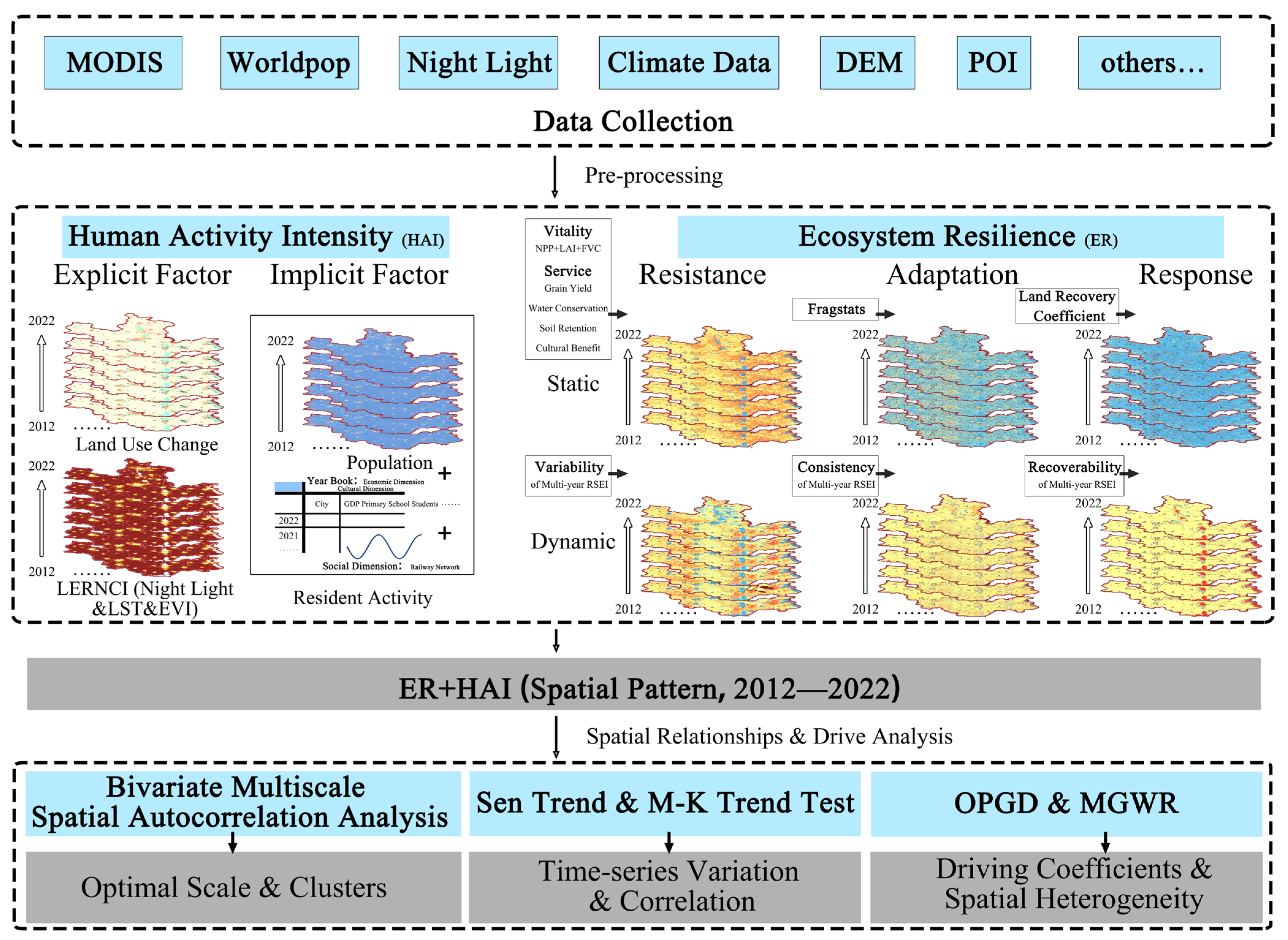
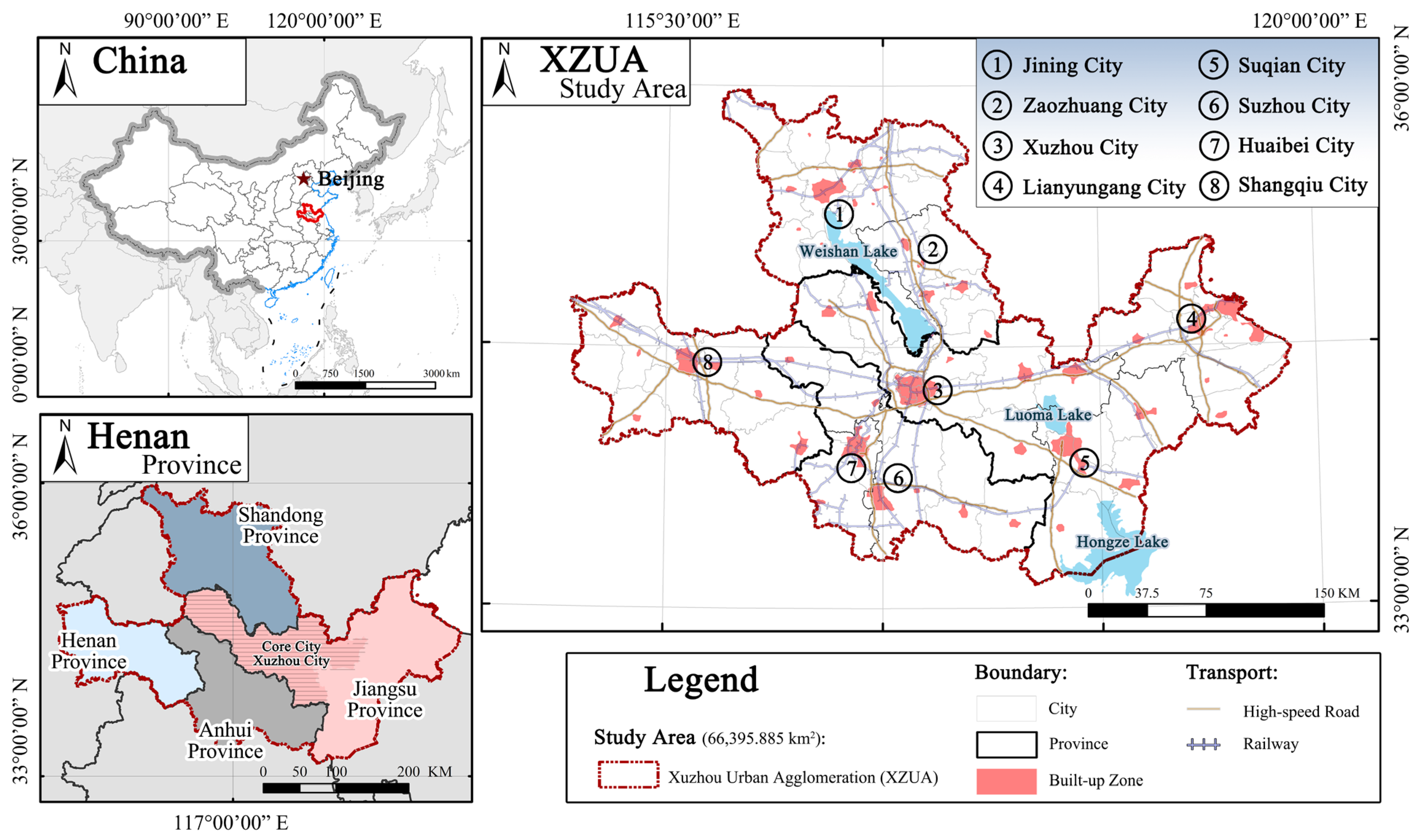
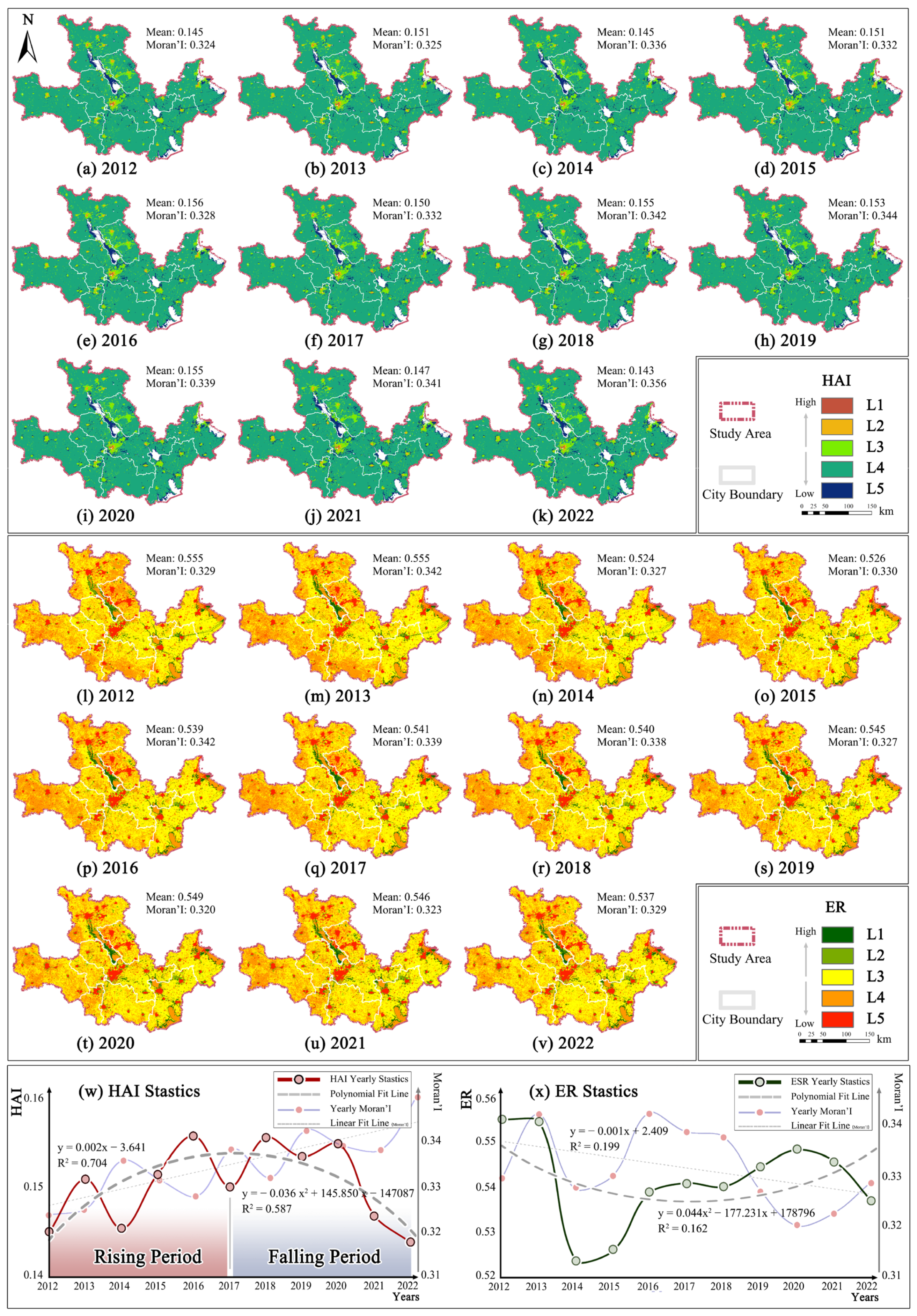
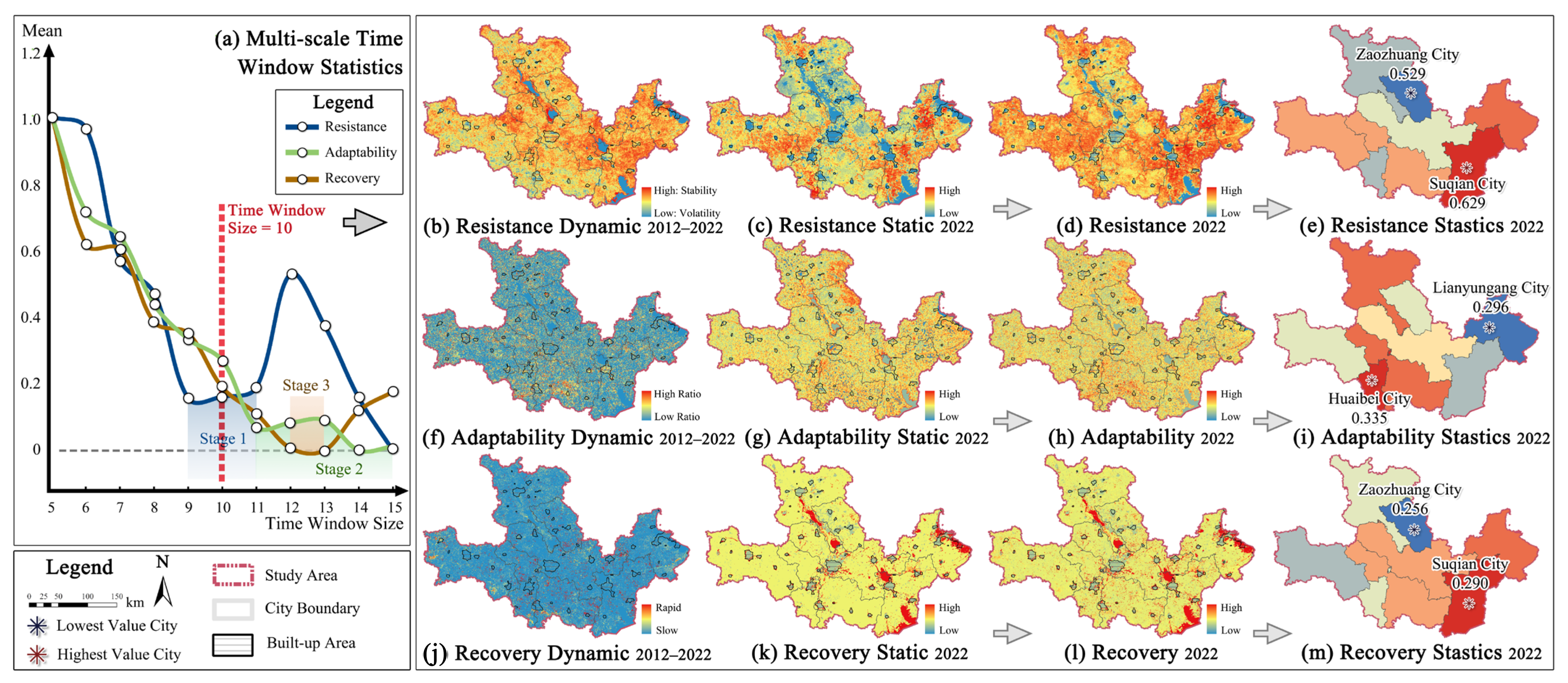


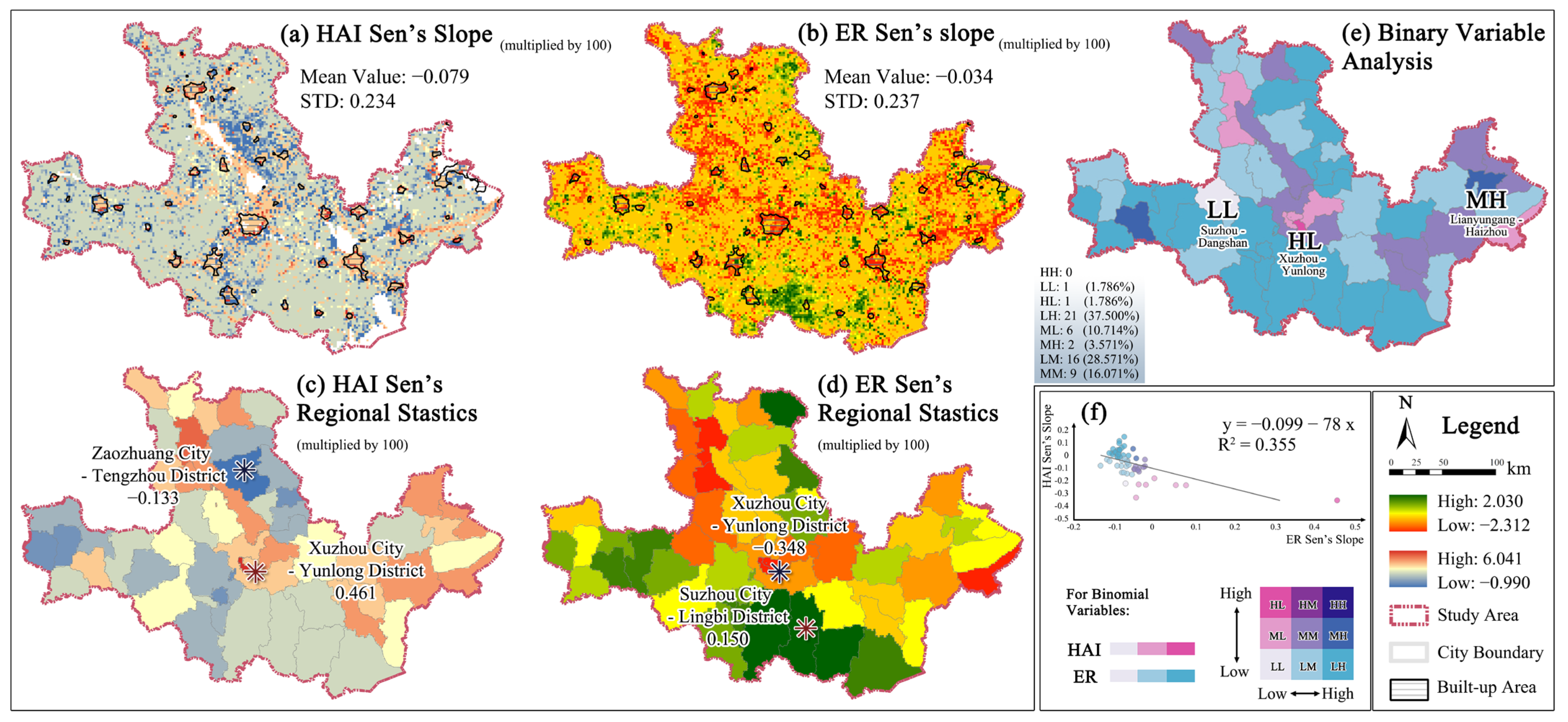

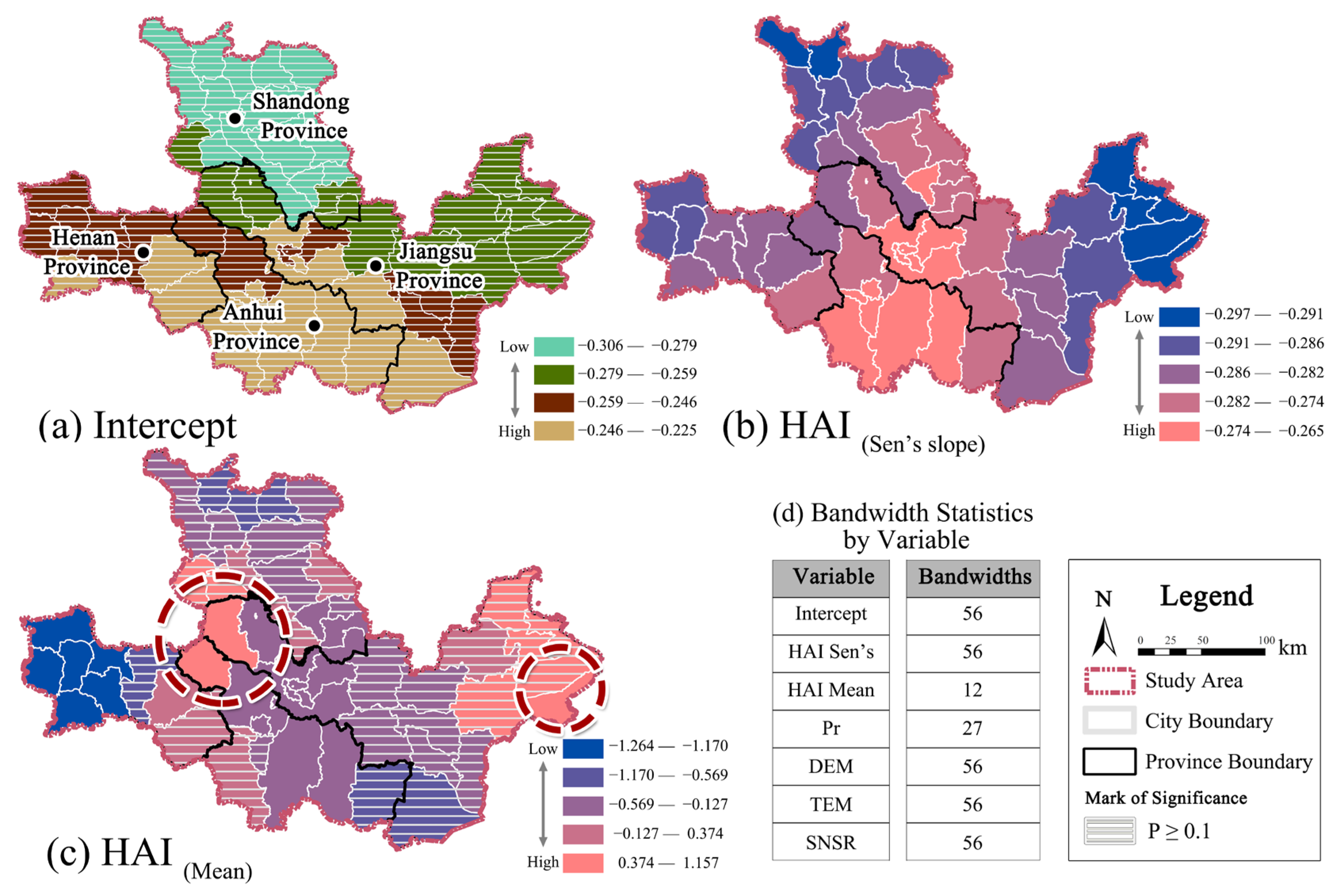
| Data | Source | Period | Temporal Resolution | Spatial Resolution |
|---|---|---|---|---|
| MODIS | GEE, MODIS/061/MOD09A1 | 2002–2022 | 8-day | 500 m |
| LULC | GEE, MODIS/061/MCD12Q1 (LC_Type1) | 2002–2022 | Yearly | 500 m |
| POP | GEE, WorldPop/GP/100m/pop | Yearly | 100 m | |
| NTL | GEE, NOAA/VIIRS/001/VNP46A2 | Daily | 500 m | |
| LST | GEE, MODIS/061/MOD11A2 | 8-day | 1000 m | |
| NDVI | GEE, MODIS/061/MOD13A1 | 16-day | 500 m | |
| EVI | ||||
| LAI | GEE, MODIS/061/MCD15A3H | 4-day | 500 m | |
| GPP | GEE, MODIS/061/MOD17A2H | 8-day | 500 m | |
| Pr | GEE, ECMWF/ERA5_LAND/MONTHLY_BY_HOUR | Monthly | 11,132 m | |
| Tem | ||||
| SNSR | ||||
| AET | GEE, IDAHO_EPSCOR/TERRACLIMATE | Monthly | 4638.3 m | |
| Runoff | ||||
| DEM | GEE, COPERNICUS/DEM/GLO30 | 2015 | - | 30 m |
| K Factor [42] | (China) National Tibetan Plateau Science Data Center (https://www.tpdc.ac.cn/, accessed on 10 December 2024) | 2020 | - | 25 m |
| ICH POI | Global Change Research Data Publishing & Repository (https://www.geodoi.ac.cn/, accessed on 2 June 2023) | 2011, 2014, 2021 | Multi-Year | - |
| HC POI | National Cultural Heritage Administration Integrated Administrative Platform (http://gl.ncha.gov.cn/, accessed on 2 June 2023) | 2019 | - | - |
| SS POI | Provincial Department of Culture and Tourism | 2020–2024 | Yearly | - |
| Railway Network | China Basic Geographic Information Database (https://www.webmap.cn/, accessed on 12 December 2024) | 2019, 2021 | Multi-Year | - |
| China Urban Statistical Yearbook | (China) National Bureau of Statistics (https://www.stats.gov.cn/, accessed on 12 December 2024) | 2013–2023 | Yearly | - |
| Service Category | Indicator | Methodology |
|---|---|---|
| Support | GY | Measurable Proxies, y = ax + b, where x = , a is calibrated based on regional GY. |
| Regulation | WC | Water Balance Equation, Q = P – R − AET, Q is water conservation, P is precipitation, R is runoff, and AET is evapotranspiration. |
| Provision | SR | RUSLE = R × K × L × S × C × P, accounting for rainfall (R), soil erodibility (K), topographic factors (L, S), and vegetation/management factors (C, P). |
| Culture | CB | Measurable Proxies, y = ax + b, where x = density; a is calibrated based on regional tourism revenue. |
| Variable | HAI Sen’s | HAI Mean | DEM | Rain | Tem | PAR |
|---|---|---|---|---|---|---|
| Spearman Correlation | −0.645 *** | −0.267 ** | 0.247 * | 0.299 ** | 0.272 ** | −0.396 *** |
| VIF | 1.069 | 1.328 | 1.617 | 1.201 | 1.499 | 1.077 |
Disclaimer/Publisher’s Note: The statements, opinions and data contained in all publications are solely those of the individual author(s) and contributor(s) and not of MDPI and/or the editor(s). MDPI and/or the editor(s) disclaim responsibility for any injury to people or property resulting from any ideas, methods, instructions or products referred to in the content. |
© 2025 by the authors. Licensee MDPI, Basel, Switzerland. This article is an open access article distributed under the terms and conditions of the Creative Commons Attribution (CC BY) license (https://creativecommons.org/licenses/by/4.0/).
Share and Cite
Wang, X.; Ge, S.; Xu, Y.; Kollányi, L.; Bai, T. Nonlinear Interactions and Dynamic Analysis of Ecosystem Resilience and Human Activities in China’s Potential Urban Agglomerations. Remote Sens. 2025, 17, 1955. https://doi.org/10.3390/rs17111955
Wang X, Ge S, Xu Y, Kollányi L, Bai T. Nonlinear Interactions and Dynamic Analysis of Ecosystem Resilience and Human Activities in China’s Potential Urban Agglomerations. Remote Sensing. 2025; 17(11):1955. https://doi.org/10.3390/rs17111955
Chicago/Turabian StyleWang, Xinyu, Shidong Ge, Yaqiong Xu, László Kollányi, and Tian Bai. 2025. "Nonlinear Interactions and Dynamic Analysis of Ecosystem Resilience and Human Activities in China’s Potential Urban Agglomerations" Remote Sensing 17, no. 11: 1955. https://doi.org/10.3390/rs17111955
APA StyleWang, X., Ge, S., Xu, Y., Kollányi, L., & Bai, T. (2025). Nonlinear Interactions and Dynamic Analysis of Ecosystem Resilience and Human Activities in China’s Potential Urban Agglomerations. Remote Sensing, 17(11), 1955. https://doi.org/10.3390/rs17111955







